From Term 1 to Term 3, the Year 7s were given Project Utopia, the task to build a utopia within Fremantle Port. Since the Fremantle Port is being moved to Kwinana, there is now an empty space which needs to be redesigned. In small groups, we have gathered to design our Future of Fremantle. Through this post, I will be explaining the process which led to our final product.
– The Giver –

During Term 2 English, we studied the book The Giver. The setting of this book described the perfect utopia, and we studied the community within it. Although utopia is defined as a perfect community, the Greek origins of this word means ‘no place’, and this was clearly illustrated in The Giver. Through the perspective of the main character Jonas, we were able to experience a perfect utopia, and discovered how dysfunctional it was and it wasn’t possible to create a utopian society. However, the flaws from this community allowed us to develop ways to build a more functional community for Fremantle. This book was the beginning step for our project, and allowed us to establish the fine line between a flawed community and a perfect utopia.
– Liveability Factors –
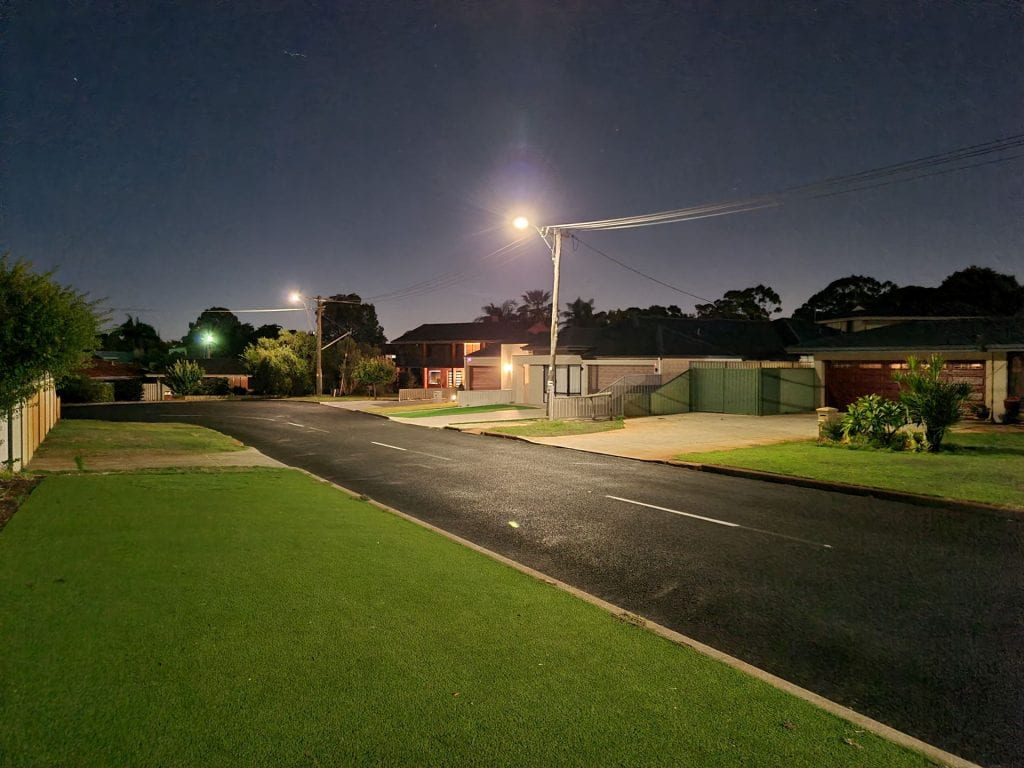
In Humanities, we began learning about different liveability factors. Liveability is measured through the number of different factors linked with the quality of life. Depending on a person’s age, income, cultural background, lifestyle preferences, values, and beliefs, they may have various perspectives on a place’s liveability. We can measure the factors that affect people’s perceptions of liveability: by objective factors and by subjective factors. Things that can be measured as numbers are considered objective factors. Examples also include cost of housing, the climate condition, the number of local hospitals and schools, the accessibility of public transportation, and the level of crime. Subjective factors are things that can’t simply be measured or stated as statistics because they are personal, emotional, and spiritual.
Several factors that influence where we live often include our needs, wants and preferences. These are constantly changing and is incredibly dependent on the stage of life the person is at. Several of these factors include housing, access to services, accessibility to jobs, climate environment, cultural connections, and entertainment. To illustrate this is everyday life, we completed an assignment to map out all infrastructure around our house within a 1.5 km radius. We found numerous key infrastructures, and then rated the liveability of our area. As you can see on the right, there is a photo of my street, as I needed to assess the street lighting. This task allowed us to see the amount of thought that went into placing infrastructure conveniently and how liveability factors affected residency.
– Excursion to Fremantle Port –
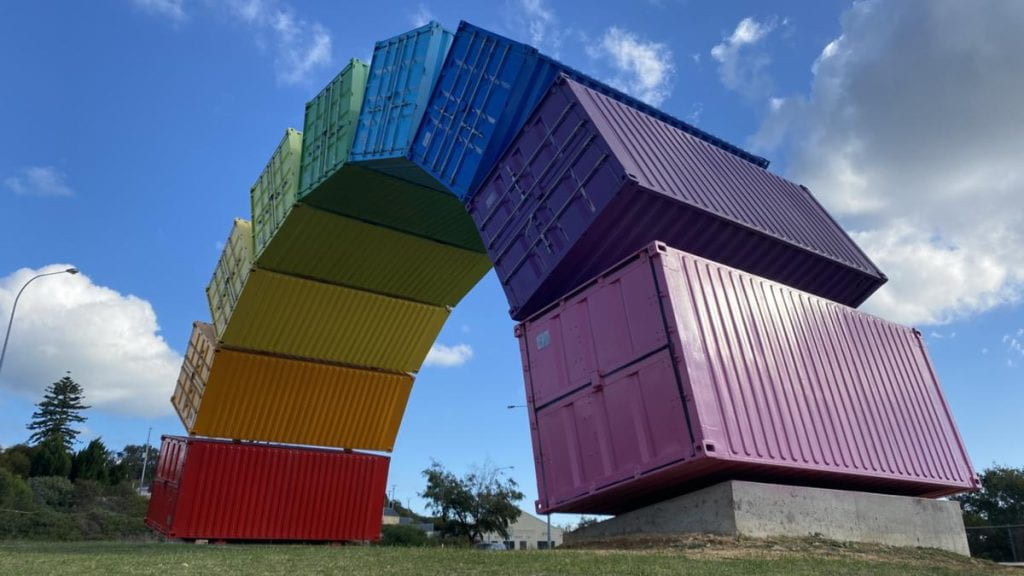
In Term 2, we had an excursion to the Fremantle Port area. Although it was short, we were able to connect with the space and learn the general flow of the society. During the excursion, we completed a workbook to keep us focused on learning more about the Fremantle Port. We learnt about the history of the port as well as taking a bus tour around the port to discover the land we were to transform. The excursion was very short, but we were able to absorb lots of information. We were able to observe our working space in action, which allowed us to understand the space a lot more. This part of the project was the empathise stage, as we connected with our audience. Overall, this excursion was key to my understanding of Fremantle Port. As you can see in this image, this was one of the structure we saw on our bus tour. The rainbow sea containers represents the shipping industry in Fremantle.
– Ideation of Utopia Questions –
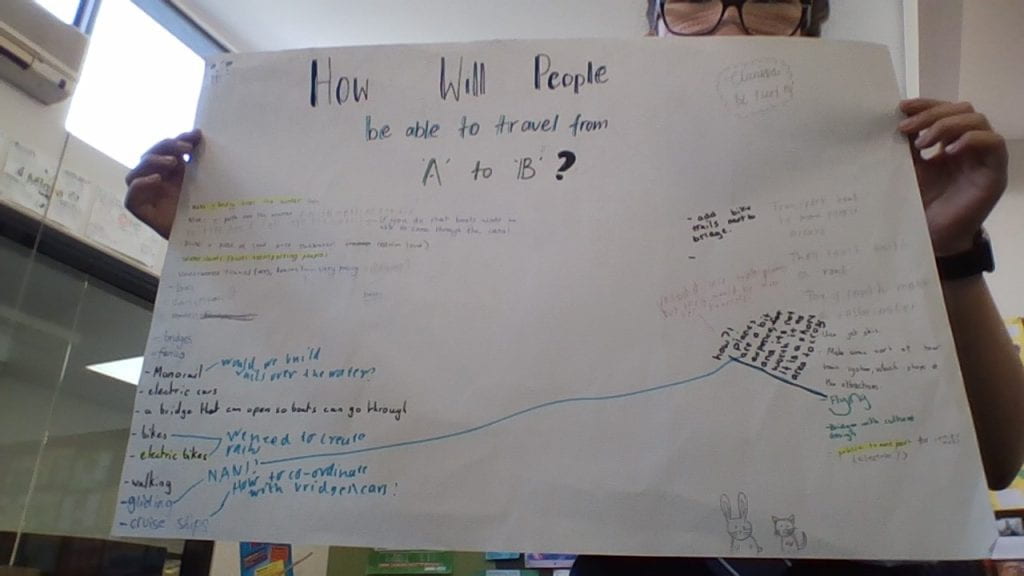
As we started our project, we mixed throughout the year group and tried to find some ideas for big questions. Several of these questions regarded to sustainability, placement of infrastructure, transportation, businesses and jobs and fun and recreation. We took turns answering each question and ended up with a big brainstorm of ideas. Although some of these ideas were too big, such as an underwater library, these ideas allowed us to find basic ideas to start off. As you can see the image, this was one of the questions which the class helped brainstorm.
– Vision Board –
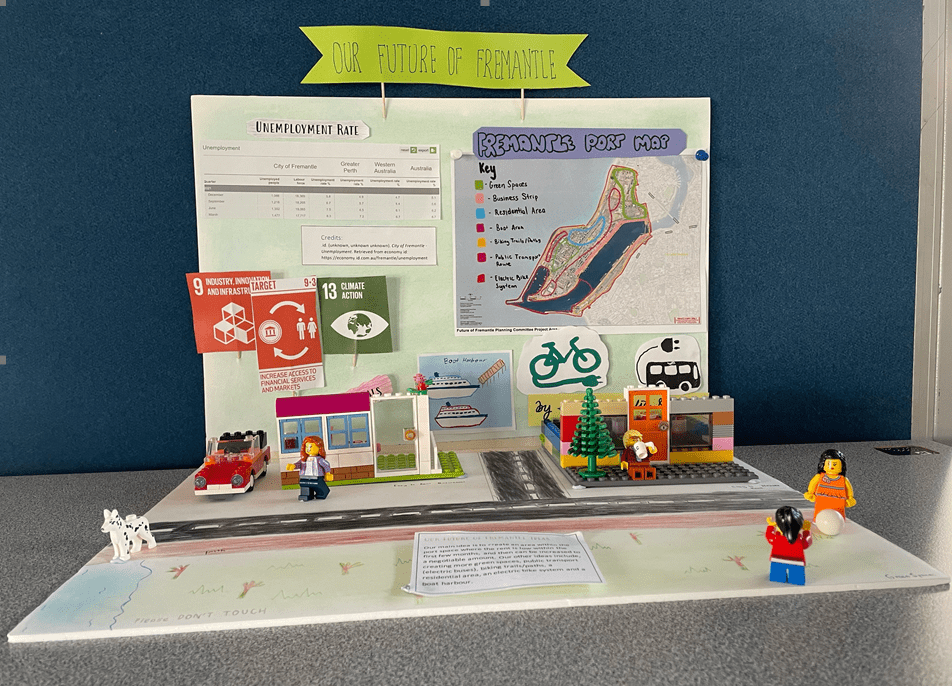
We then created a vision board, a visual representation of our goals and ideas. This was then shown on Grandparents’ morning.
Firstly, we were placed in groups of 3, to create a vision board of our main ideas. I was placed in a group with Jarvis and Amelia, and we came up with the idea to lower rent. In Fremantle March 2022, the unemployment rate was 5.2%, which was relatively high. To increase employment, we came up with the idea to make it easier to afford property, by allowing low rent for a particular amount of time. This became our centre idea, although we had some side ideas such as sustainability and transport.
On the vision board, we illustrated our ideas through building a LEGO version of our rental ideas. We built LEGO houses, explaining the affordability and conveniency to have a business or home in Fremantle, thus causing more residency and tourism. These places will also provide jobs for residents, as the median age is 41. We also drew a rough sketch of our map, which was later found quite inaccurate. It included the different purposes of each area, such as residential, retail, recreation and green spaces. It also incorporated the Global Goals, a set of goals to be achieved by 2030. We face big challenges in our world today such as poverty, hunger, inequality, and climate change. These challenges require bold action to overcome, and this is where the 17 Global Goals come in. They are a plan to build a greener, fairer, better world and everybody has a role in achieving them. Our main idea related to Goal 9 (Industry, Innovation and Infrastructure), as well as Goal 13 (Climate Change).
The day we presented our vision boards was Grandparents’ Day, a day dedicated to our grandparents. Us students would invite our grandparents to All Saints’ College, for a performance and morning tea in the CPA, and then a presentation of our vision board in the C Block. This day was organised by the student representatives. As I was a student representative in Semester 1, I worked with the rest of the team, organising the morning. Overall, it went smoothly, with a piano performance by Edward, dance routine and a short video about our year so far. During our presentation, only Jarvis’ grandparents came, but they thoroughly enjoyed our idea.
One key element from our presentation, was the fact that this was almost like a practice pitch. We were able to receive feedback from our audience and figure out how to make our ideas more effective, affordable and realistic. I enjoyed spending the morning with all the grandparents’ and sharing our ideas.
– Future of Fremantle Report –

Shortly after presenting our vision boards, we were assigned the Future of Fremantle Report. This comprised of answering three of the key questions from the ideation. We were to write a section each, and write the introduction, conclusion, and map together. Amelia focused on the transport factor and explained the sustainability and conveniency of different transport. Jarvis focused on the sustainable factor and described the various ideas involving sustainability. I decided to focus on one of the hardest questions, What Businesses and Jobs might locate there once Port uses are relocated? This was because this was the one most related to our rental idea.
At first, I didn’t realise that this question was incredibly difficult, and required a lot of research. However, this assignment helped me create stronger research skills, as I tried to create a better understanding of this question. I answered this question through explaining a purpose for each area in the space. This included residential, commercial, health care and essential services and recreational places. A similar idea that has been previously used and successful, is Port Coogee. This was once used for cattle shipping, but now is transformed into a beautiful residential space, with access to recreation, essential services, and businesses. Through this question, I was able to understand Project Utopia much more, and create a foundation before our final showcase.
As well as this, we designed a map for our report. This consisted of a residential, commercial, health care and essential services and recreational areas. It also had a public transport system, side walks and a boat harbour.
Overall, this assignment produced a stronger understanding of what our final product was going to look like and built up our collaborative skills.

– English Assessment – Urbanized –
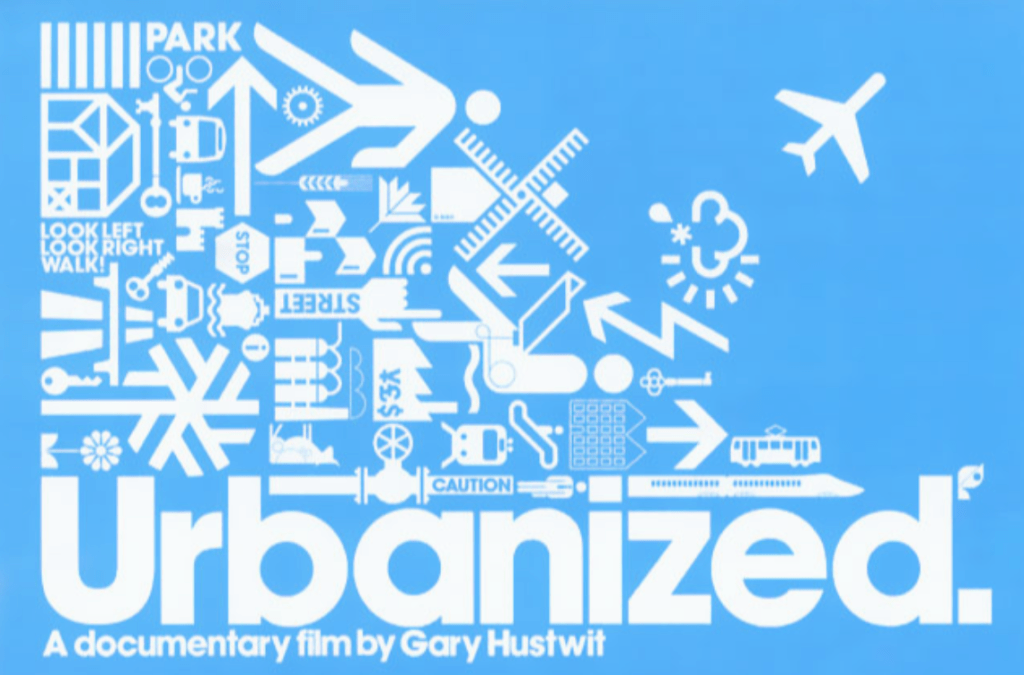
In English, we began to study the documentary Urbanized, by Gary Hustwit. This documentary was about how a new approach is being tried by politicians, city planners, architects, and others to address the benefits and disadvantages of living in an urban environment. We learn about how different countries tried to improve their liveability, through energy-saving, lowering crime rate, encouraging cycling and other strategy.
For this assessment, there were two key parts. Firstly, we were to choose two countries from ‘Urbanized’ and explain how they have used observation, exposition, mise en scene, dramatisation and interviews. I chose Copenhagen and New York Community, as these mostly related to my group’s Project Utopia ideas. These countries involved the ideas of cycling and creating a harmonious relationship between physical space and social fabric. The second part of this assessment was writing a credible paragraph on how our Project Utopia ideas were linked to ‘Urbanized’.
In conclusion, this project built up my persuasive skills, allowing me to become more credible and reliable.
– Model & CoSpaces –

In Term 3, we began creating 3D models of our ideas. We first got into groups, based on what questions we did for the Future of Fremantle report. I ended up in a group with Aditya, Sam Lim and Havish. Additionally, each group was assigned a particular idea for the model. We were given the idea of infrastructure and jobs and opportunities. However, we were assigned two pieces of the full model, making it harder to finish, especially as we had quite a small group with a big idea.
We were also to make an online version of our model using CoSpaces, which had augmented reality. It was slightly difficult to use CoSpaces, but we adapted and created a detailed version of our idea which was practically a virtual version of our 3D model. We colour – coded the different purposes of the buildings, to make it easier for our audience to understand.
Our 3D model had a scale of 1cm per 24m, like the rest of the class. Our model had several disadvantages, such as the wrong placement of buildings. This was because we were slightly rushing and didn’t completing focus on where we were placing buildings. Although they weren’t perfect, they weren’t direly placed, and still allowed the community to function. On the other hand, there were many benefits to our model. Our model was an accurate representation of our plan and had all the infrastructure that Fremantle needed to function. It also built up our motor skills and gave us experience to work with different materials. We learnt to work as a group and learn each other’s weaknesses and strengths.
Our model idea was very similar to my Future of Fremantle report idea. We introduced infrastructure from the residential, commercial, recreational and essential services categories. We had many different pieces of infrastructure on our model, which made it incredibly detailed and time-consuming. However, I enjoyed learning to work with materials, and working as a team. We also incorporated some green spaces (credits to Nishaan). Since we had such a big amount of work, and not many group members, I was extremely grateful for my classmates which sacrificed their time to help my group.
One time, we needed to sacrifice our lunch time for our model. After discussing this with Mr Wong, he said to meet at the class at 1:10pm, instead of 1:00pm because he had to eat his burrito. So, that’s what we did. But he didn’t come. So, we just went in, and Nishaan just supervised us 😊. Then at around 1:25pm, Mr Wong ran in yelling “I’m so sorry, I forgot!” In my opinion, it was sort of funny to see another Mr Wong moment in action, but anyways…
The model was almost like a big puzzle, every piece linking to another. It was all connected and created a community worth living in for Fremantle.
– Final Showcase –

Soon, it was time for the final showcase. The final showcase was an English assessment, where we gave a pitch on our idea (Infrastructure and Jobs and Businesses). We were to summarise the entire Project Utopia course and explain our idea in more detail. We presented twice – once to the class and once to our parents. When presenting, we used multimodal texts such as our model and CoSpaces. We had to have credibility and explain why our idea was the best one. There were NO PASSENGERS allowed.
As a group, we worked together to create a script, and then gave parts to each other. We had time to rehearse in class and placed our presentation together.
On the day, we had three rounds of presenting. The first one consisted of all our parents, and the others had a singular person as our audience. As time passed on each pitch, we became better and better at presenting. I really enjoyed the experience to practise my public speaking skills and speak to various audiences.

– Capabilities –

At All Saints’, we have the ASC capabilities, a list of capabilities to making a positive different. Over the course of Project Utopia, we used several different capabilities.
– Collaborative –
Over the course of Project Utopia, we worked in groups I would usually not choose. However, it allowed me to develop better relationships with people in my class and learn how to work with different people. Collaboration is a key ability in the real world, so being to see it in work in action was inspiring.
– Effective Communication –
When working in groups, its important that everybody has effective communication. Effective communication. The process of exchanging ideas, opinions, knowledge, and facts in order to ensure that the message is received and understood with clarity and purpose is known as effective communication. It also means that you have the ability to listen, comprehend, and act upon what other people say. In our group, we had multiple chats to discuss questions and post information. We listened to each other and incorporated our small ideas into our main idea. This allowed us to finish our work as a group.
– Leadership –

When working in groups, its important that everybody has effective communication. Effective communication. The process of exchanging ideas, opinions, knowledge, and facts in order to ensure that the message is received and understood with clarity and purpose is known as effective communication. It also means that you have the ability to listen, comprehend, and act upon what other people say. In our group, we had multiple chats to discuss questions and post information. We listened to each other and incorporated our small ideas into our main idea. This allowed us to finish our work as a group.
– Resilient –
When building our model, we had to be resilient and rely on each other. Since we had many small buildings, it would take hours to finish a section of buildings. Therefore, we had to be resilient and trust that each of us were doing our part for our project.
– Organised –
When completing almost all assignments in Project Utopia, it was vital that we were organised to get our work to top-notch before the deadline. We set little goals to finish different parts at different dates before the deadline. This allowed us to view the work as a whole group before it was presented or submitted.
– Final Conclusion –

Overall, Project Utopia built up many learning skills, and created a strong foundation for future projects. I thoroughly enjoyed each stage of this project, and I would like to thank all the staff members, guest speakers and classmates for making this experience possible.